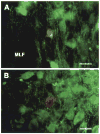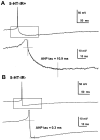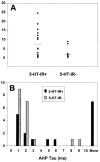Distinguishing characteristics of serotonin and non-serotonin-containing cells in the dorsal raphe nucleus: electrophysiological and immunohistochemical studies
- PMID: 12573710
- PMCID: PMC2832757
- DOI: 10.1016/s0306-4522(02)00584-5
Distinguishing characteristics of serotonin and non-serotonin-containing cells in the dorsal raphe nucleus: electrophysiological and immunohistochemical studies
Abstract
The membrane properties and receptor-mediated responses of rat dorsal raphe nucleus neurons were measured using intracellular recording techniques in a slice preparation. After each experiment, the recorded neuron was filled with neurobiotin and immunohistochemically identified as 5-hydroxytryptamine (5-HT)-immunopositive or 5-HT-immunonegative. The cellular characteristics of all recorded neurons conformed to previously determined classic properties of serotonergic dorsal raphe nucleus neurons: slow, rhythmic activity in spontaneously active cells, broad action potential and large afterhyperpolarization potential. Two electrophysiological characteristics were identified that distinguished 5-HT from non-5-HT-containing cells in this study. In 5-HT-immunopositive cells, the initial phase of the afterhyperpolarization potential was gradual (tau=7.3+/-1.9) and in 5-HT-immunonegative cells it was abrupt (tau=1.8+/-0.6). In addition, 5-HT-immunopositive cells had a shorter membrane time constant (tau=21.4+/-4.4) than 5-HT-immunonegative cells (tau=33.5+/-4.2). Interestingly, almost all recorded neurons were hyperpolarized in response to stimulation of the inhibitory 5-HT(1A) receptor. These results suggested that 5-HT(1A) receptors are present on non-5-HT as well as 5-HT neurons. This was confirmed by immunohistochemistry showing that although the majority of 5-HT-immunopositive cells in the dorsal raphe nucleus were double-labeled for 5-HT(1A) receptor-IR, a small but significant population of 5-HT-immunonegative cells expressed the 5-HT(1A) receptor. These results underscore the heterogeneous nature of the dorsal raphe nucleus and highlight two membrane properties that may better distinguish 5-HT from non-5-HT cells than those typically reported in the literature. In addition, these results present electrophysiological and anatomical evidence for the presence of 5-HT(1A) receptors on non-5-HT neurons in the dorsal raphe nucleus.
Figures









Similar articles
-
Median and dorsal raphe neurons are not electrophysiologically identical.J Neurophysiol. 2004 Feb;91(2):994-1005. doi: 10.1152/jn.00744.2003. Epub 2003 Oct 22. J Neurophysiol. 2004. PMID: 14573555 Free PMC article.
-
Neurochemical and anatomical identification of fast- and slow-firing neurones in the rat dorsal raphe nucleus using juxtacellular labelling methods in vivo.Neuroscience. 2003;122(1):193-204. doi: 10.1016/s0306-4522(03)00518-9. Neuroscience. 2003. PMID: 14596860
-
5-HT(1A) agonist potential of pindolol: electrophysiologic studies in the dorsal raphe nucleus and hippocampus.Biol Psychiatry. 2000 Jun 15;47(12):1050-5. doi: 10.1016/s0006-3223(99)00322-4. Biol Psychiatry. 2000. PMID: 10862804
-
Control of dorsal raphé 5-HT function by multiple 5-HT(1) autoreceptors: parallel purposes or pointless plurality?Trends Neurosci. 2000 Oct;23(10):459-65. doi: 10.1016/s0166-2236(00)01631-3. Trends Neurosci. 2000. PMID: 11006462 Review.
-
The role of dorsal raphe nucleus serotonergic and non-serotonergic neurons, and of their receptors, in regulating waking and rapid eye movement (REM) sleep.Sleep Med Rev. 2010 Oct;14(5):319-27. doi: 10.1016/j.smrv.2009.10.003. Epub 2010 Feb 12. Sleep Med Rev. 2010. PMID: 20153670 Review.
Cited by
-
A subpopulation of serotonergic neurons that do not express the 5-HT1A autoreceptor.ACS Chem Neurosci. 2013 Jan 16;4(1):89-95. doi: 10.1021/cn300157s. Epub 2012 Nov 7. ACS Chem Neurosci. 2013. PMID: 23336048 Free PMC article.
-
Association with reward negatively modulates short latency phasic conditioned responses of dorsal raphe nucleus neurons in freely moving rats.J Neurosci. 2013 Mar 13;33(11):5065-78. doi: 10.1523/JNEUROSCI.5679-12.2013. J Neurosci. 2013. PMID: 23486976 Free PMC article.
-
Effect of the CB(1) receptor antagonists rimonabant and AM251 on the firing rate of dorsal raphe nucleus neurons in rat brain slices.Br J Pharmacol. 2009 Nov;158(6):1579-87. doi: 10.1111/j.1476-5381.2009.00434.x. Epub 2009 Oct 20. Br J Pharmacol. 2009. PMID: 19845674 Free PMC article.
-
Differential expression of 5HT-1A, alpha 1b adrenergic, CRF-R1, and CRF-R2 receptor mRNA in serotonergic, gamma-aminobutyric acidergic, and catecholaminergic cells of the rat dorsal raphe nucleus.J Comp Neurol. 2004 Jun 28;474(3):364-78. doi: 10.1002/cne.20138. J Comp Neurol. 2004. PMID: 15174080 Free PMC article.
-
Failure to mount adaptive responses to stress results in dysregulation and cell death in the midbrain raphe.J Neurosci. 2008 Aug 13;28(33):8169-77. doi: 10.1523/JNEUROSCI.0004-08.2008. J Neurosci. 2008. PMID: 18701679 Free PMC article.
References
-
- Albert PR, Zhou QY, Van Tol HH, Bunzow JR, Civelli O. Cloning, functional expression, and mRNA tissue distribution of the rat 5-hydroxytryptamine1A receptor gene. J Biol Chem. 1990;265:5825–5832. - PubMed
-
- Allers KA, Sharp T. Identification of 5-HT containing neurones in the dorsal raphe nucleus (DRN) using juxtacellular labeling methods in vivo. Soc Neurosci Abs. 2001;27:806–13.
-
- Azmitia EC, Gannon PJ, Kheck NM, Whitaker-Azmitia PM. Cellular localization of the 5-HT1A receptor in primate brain neurons and glial cells. Neuropsychopharmacology. 1996;14:35–46. - PubMed
-
- Baraban JM, Aghajanian GK. Suppression of firing activity of 5-HT neurons in the dorsal raphe by alpha-adrenoceptor antagonists. Neuropharmacology. 1980;19:355–363. - PubMed
Publication types
MeSH terms
Substances
Grants and funding
- RC1 MH089800/MH/NIMH NIH HHS/United States
- R21 MH099488/MH/NIMH NIH HHS/United States
- NS 28512/NS/NINDS NIH HHS/United States
- R01 MH063078/MH/NIMH NIH HHS/United States
- MH60773/MH/NIMH NIH HHS/United States
- R01 NS028512/NS/NINDS NIH HHS/United States
- MH63078/MH/NIMH NIH HHS/United States
- DC 04098/DC/NIDCD NIH HHS/United States
- P01 MH048125/MH/NIMH NIH HHS/United States
- R03 MH060773/MH/NIMH NIH HHS/United States
- R01 MH075047/MH/NIMH NIH HHS/United States
- F32 MH012274/MH/NIMH NIH HHS/United States
- MH 12274/MH/NIMH NIH HHS/United States
- MH 58250/MH/NIMH NIH HHS/United States
LinkOut - more resources
Full Text Sources
Other Literature Sources

